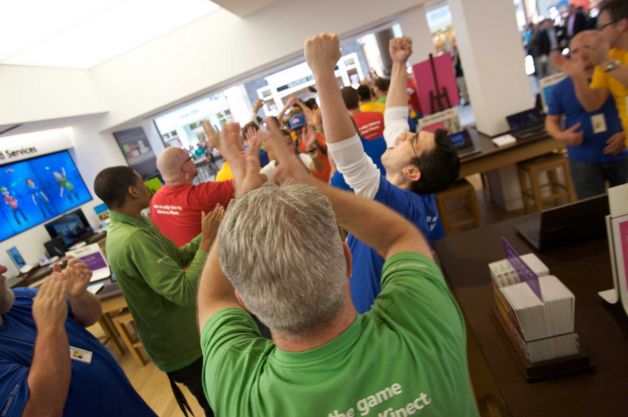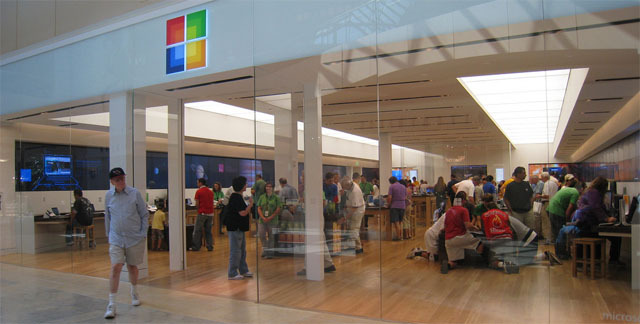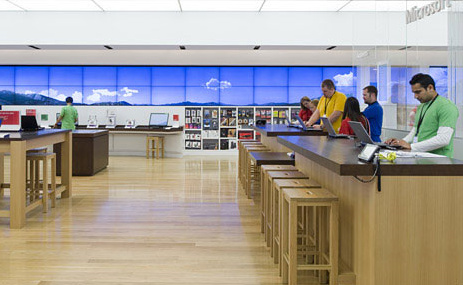We’ve spent a lot of time in class discussing the customer’s growing power in today’s marketplace, but what companies actually commit to change and create environments and dialogues that are more valuable to the customer?
And then I walked into one of the new Microsoft retail stores.
I was wandering through the Mall of America (for the first time), adoring the variety of stores and the enormous amusement park, when I stumbled across what I thought was an Apple store. The storefront was completely glass. Inside was white and clean-cut, very simplistic, with light-colored wood flooring. Long tables with were set up in rows across the store-each a different station for trying different products.
Almost everyone has been to an Apple store or has seen an Apple store. Doesn’t this sound like one?
Well, that’s what I thought…until I glanced to my right and noticed the actual Apple store. What I described above was actually a Microsoft store.
Apple and Microsoft’s Rivalry
Almost anyone can recall the “Get a Mac” campaign, and nothing exemplifies the rivalry between Apple and Microsoft more than these commercials.
To recap, a younger man and an older man personify each computer system, a Mac and PC respectively. Each add described different characteristics, but overall describes Macs as reliable, compatible with other technology, easier to use, and “cooler.” PC’s are described as slow, older models, not compatible, less secure, and “less hip.”
As a Mac user, I completely agree with this stereotype. In my own experience, my PC was slow, Windows had lots of defects, and I always got viruses on my computer. Meanwhile, my Mac is easy, fast, and I have never gotten a virus. It’s reliable. And I always have onsite assistance at the Apple store if i need help with software or have questions.
I know many others have had similar experiences with PCs and now prefer Macs, especially students. But how did Microsoft initially react to this campaign? Through this lame attempt-the commercial below, of course.
What Microsoft has learned from Apple
Create retail locations.
The creation of retail locations has allowed Microsoft to develop relationships with their customers. Coming to a tangible location to ask questions and get a feel for the products is less intimidating than calling Microsoft’s customer service line or ordering offline.
“Microsoft retail stores – both brick-and-mortar locations and seasonal holiday stores – have become a vital way for the company to develop closer relationships with consumers, and conversely, to put consumers directly in touch with Microsoft technology,” said Jonathan Adashek, general manager of Communications Strategy.
They are also set up similarly to Apple stores- each are simplistic, with long wooden tables that display gadgets, a wall of accessories, and a station for tech support.
Place importance on customer service.
Apple’s employee training program places emphasis on one major concept: it is more important to help the customer solve their problem than push merchandise. The Wall Street Journal interviewed employee’s about their training experiences and compared their observations of the employee’s responses to therapists. The confidential training manual actually reads “Listen and limit your responses to simple reassurances that you are doing so. ‘Uh-huh,’ ‘I understand,’ etc.”
This is where Apple succeeds. They create an atmosphere where the customer is in control. What the customer needs, wants, and feels dominates the conversation. Employees are attentive, perceptive, and reassuring.
Not only this, but Apple provides in-store classes to learn the Mac software and a Genius bar for on-staff technology assistance.
Microsoft has taken the hint. Ryan Scott, a Microsoft store manager, describes Microsoft’s mission as customer satisfaction and service oriented.“From the second they walk in the store, whether they buy anything or not, I want them to have a world-class experience and walk out with that wow factor so when they think about Microsoft they think about incredible service, the best technology in the world, and they then want to share that with their friends and family,” he says.
Physical locations have given Microsoft the opportunity to open conversations with customers about their products and get a better feel for the brand.
How Microsoft is going above and beyond
Incentives for attending store openings.
Every store opening features a special performance from popular musicians. Past performances have included Maroon 5, Kelly Clarkson, Enrique Iglesias, and Black Keys.
Community giving at every store opening.
Microsoft views store openings as a way for them to connect with the community. It allows them to introduce their products, company, brand, and store while supporting important groups in local communities.
In every community where Microsoft opens a store, they give software grants to organizations within that community. For example, at the Corte Madera store opening, Microsoft gave a $250,000 technology grant to the the Children’s Creativity Museum and the non-profit organization Girls Inc. They also gave a $1 million grant to Junior Achievement of Northern California.
New job title: community development specialist.
Microsoft created a position at every store that specializes in organizing in-store events and activities to raise awareness of causes in the community while providing opportunities to learn new technology.
Each store has theatre space.
Theatre space is provided to give space to community organizations to use for free.
Are you still a Mac user?

Microsoft employees excited and enthusiastic at the opening of a store location in the UK, via hexus.net
It’s clear that Microsoft is making strides at improving their company and brand image, but many have argued that the similarities between Apple and PC stores are a huge turn-off. But who can blame Microsoft for following suit? The Wall Street Journal reported that “more people now visit Apple’s 326 stores in a single quarter than the 60 million who visited Walt Disney Co.’s four biggest theme parks last year.”
Customers demanded better customer service, more answers, more help, and easier technology. They want to be understood and heard. The retail store was the best answer.
Their first store opened in Scottsdale, Arizona, in 2009, and currently operates 43 stores. And every store is strategically located in proximity to Apple stores. Why? To reassert them as a competitor- and a darn good one to say no too.
Not only this, but they are playing Mac’s game even better than Mac. Microsoft has not only set priority on providing the best customer service (so good that one report says that an employee offered a customer a Diet Coke while browsing the store!), but they have made it their mission to connect and help the community. Their technology grants, theatre, and in-store activities allow the communities to engage with the brand and develop new brand perceptions.
They may be copying Mac’s retail look and customer service agenda, but who’s to say they aren’t spitting better game?
This post is a part of a series of posts for Integrated Marketing Communications class that explores strategies of integrated marketing communications and recognizes strong and weak branding strategies today.
Sources:
http://www.adweek.com/news/technology/apples-retail-philosophy-132549
http://www.microsoft.com/en-us/news/Features/2012/nov12/11-08MicrosoftStores.aspx
http://nymag.com/daily/intelligencer/2013/02/pleasant-trip-to-the-microsoft-store.html



